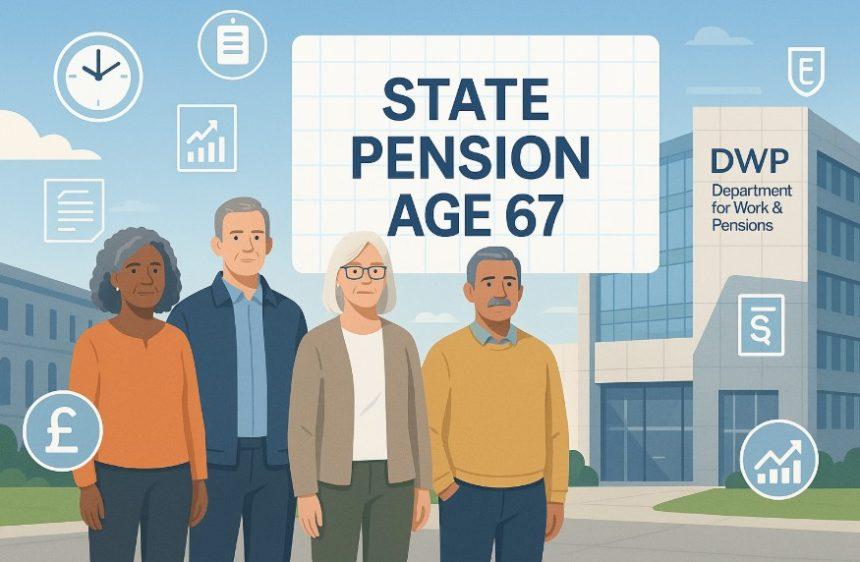|
Getting your Trinity Audio player ready...
|
Have you been planning your retirement, assuming you’ll receive your State Pension at 66? If you were born in the early 60s or mid-70s, it’s time to revisit those expectations. The Department for Work and Pensions (DWP) has confirmed that changes to the State Pension age will begin in April 2026.
This shift marks a significant adjustment in the UK’s retirement landscape, impacting millions across the country. Understanding who’s affected, when it will happen, and why it’s being implemented is critical for anyone nearing retirement.
Whether you’re just approaching your 60s or helping a family member prepare for retirement, knowing the facts will help you make informed financial decisions.
The change might mean working longer or adjusting your retirement planning altogether. In this blog, we’ll break down everything you need to know about the DWP 2026 State Pension Age Change and how it could impact your future.
What Is the DWP 2026 State Pension Age Change?

The DWP 2026 State Pension Age Change refers to the scheduled increase in the minimum age at which individuals in the UK can start receiving the State Pension. Currently, the State Pension age is set at 66 for both men and women.
From April 2026, this will begin rising gradually to 67. This policy update has been introduced through changes brought about by the Pensions Act 2014, which accelerated the pension age adjustment initially planned for a later period.
The pension age will rise in stages, affecting people born between 6 April 1960 and 5 April 1977, who will no longer be able to claim their pension exactly at 66. Instead, they’ll receive it at 66 years and a specified number of months, depending on their birth date.
- Applies equally to both men and women
- Affects individuals born post-April 1960 through April 1977
- Based on a phased implementation over two years
This isn’t a sudden overhaul but rather a staggered timeline, giving people a chance to adapt. Still, it’s crucial to understand how this change applies to you and what it means for your retirement outlook.
When Will the State Pension Age Change Take Effect?
The changes to the State Pension age will officially begin in April 2026, and they’ll be implemented in phases until March 2028. This gradual shift is intended to make the transition smoother and more predictable for those affected. Instead of jumping from 66 to 67 overnight, people will reach State Pension age in monthly increments depending on their birth date.
The Pensions Act 2014 brought this change forward by eight years, meaning that if you were born between 6 April 1960 and 5 April 1961, you won’t reach pension age exactly on your 66th birthday.
- Example: If you were born in May 1960, your pension age will be 66 years and 2 months
- People born after 5 April 1977 will automatically reach pension age at 67
This shift marks one of the most structured and predictable transitions in recent pension reforms. Knowing your precise retirement age is essential to avoid financial surprises later.
Why Is the DWP Increasing the State Pension Age in 2026?

The government’s decision to raise the pension age is rooted in financial necessity and demographic changes. When the State Pension was first introduced in 1948, life expectancy was around 66. Today, that number exceeds 80. With people living longer and drawing pensions for two decades or more, the financial strain on the public system has intensified.
The cost of funding State Pensions in the UK has risen to over £100 billion annually. As the population ages and the ratio of workers to retirees shrinks, the current system is becoming unsustainable.
- Rising life expectancy
- Increasing public expenditure
- Need for system sustainability
These reforms aim to strike a balance between fairness for taxpayers and continued financial support for retirees. While not without criticism, this adjustment is seen as essential to keep the pension system viable for future generations.
Who Will Be Affected by the Pension Age Increase?
If you were born between 6 April 1960 and 5 April 1977, you’ll be directly impacted by the 2026 pension age change. The increase applies to both men and women equally and affects people reaching retirement over the next few years.
Some individuals will reach pension age at 66 years and a few months, depending on their specific birth date.
Here is a breakdown of how the change will apply to different age groups:
| Date of Birth | New State Pension Age |
| 6 Apr – 5 May 1960 | 66 years and 1 month |
| 6 May – 5 Jun 1960 | 66 years and 2 months |
| 6 Jun – 5 Jul 1960 | 66 years and 3 months |
| 6 Jul – 5 Aug 1960 | 66 years and 4 months |
| 6 Aug – 5 Sep 1960 | 66 years and 5 months |
| 6 Sep – 5 Oct 1960 | 66 years and 6 months |
| 6 Oct – 5 Nov 1960 | 66 years and 7 months |
| 6 Nov – 5 Dec 1960 | 66 years and 8 months |
| 6 Dec – 5 Jan 1961 | 66 years and 9 months |
| 6 Jan – 5 Feb 1961 | 66 years and 10 months |
| 6 Feb – 5 Mar 1961 | 66 years and 11 months |
| 6 Mar 1961 – 5 Apr 1977 | 67 years |
Understanding where your birth date falls in this timeline is crucial for planning your retirement. If you’re in the affected group, your retirement timeline might need to be adjusted accordingly.
How Could the Pension Age Change Impact Your Retirement Plans?

For many, the pension age increase will mean reconsidering when and how to retire. If you’re relying heavily on the State Pension as a primary source of income, the delay in receiving it may require financial adjustments.
Financial Planning Concerns
You may need to work longer or increase personal savings to cover the gap. This change can affect budgeting, particularly for those with limited private pensions.
Retirement Timeline Adjustments
Your expected retirement age may no longer align with your financial goals or health situation. Adjusting the age at which you retire voluntarily could help you stay on track.
Effect on Long-term Savings
If you’re contributing to a private or workplace pension, now’s the time to reassess your contributions. You might also consider diversifying your savings strategy.
- Recalculate your retirement age
- Review workplace pension contributions
- Estimate the savings needed for an extended pre-pension period
Planning now helps you avoid future stress. By staying ahead, you’ll retain control over your retirement journey.
What Are Your Options If You’re Affected?
If you fall within the affected age group, there are several practical steps you can take to minimise the impact. First, it’s essential to know your precise pension age using the GOV.UK State Pension age calculator.
You can consider deferring your retirement if financially feasible, allowing your workplace pension or savings to grow. Alternatively, assess whether early retirement is an option through personal savings or investments.
- Use the official State Pension age calculator
- Evaluate your private pension savings
- Adjust your expected retirement date
Other options include increasing contributions to your private pension, reducing debt, or even switching to part-time work before full retirement. Making these adjustments early can make a significant difference when the time comes to retire.
What Support or Advice Can You Get from the DWP?

The DWP offers several support services to help you plan for the upcoming changes. One of the best places to start is the State Pension forecast tool available on the GOV.UK website. This gives you a personalised estimate of your pension and your eligible age.
Where to Find Accurate Advice?
You can access tools like the Pension Age Checker and National Insurance record viewer. These help you see if you’re on track for a full pension.
DWP Helplines and Tools
If you’re confused or need further assistance, the DWP offers phone support and online services tailored to State Pension questions.
Planning Resources Available
There are planning calculators, financial guides, and referrals to professional advisers that help you create a retirement strategy.
- Check your pension age and amount on GOV.UK
- Speak with a DWP pension specialist
- Use planning tools to revise your financial future
Taking advantage of these services helps ensure that you’re making well-informed decisions for your retirement.
Is There Any Opposition or Public Concern?
Yes, there has been ongoing public debate around the fairness and timing of the 2026 pension age change. Critics argue that individuals in physically demanding jobs or with shorter life expectancies may be disproportionately impacted.
Campaigners and MPs have raised concerns about how the increase may further disadvantage vulnerable populations, particularly women who already faced previous pension changes under the WASPI campaign.
- Public petitions challenging the decision
- MPs and advocacy groups calling for review
- Criticisms over lack of communication and transition support
While the policy is legally in place, the pressure from public discourse could influence future adjustments or lead to concessions for specific groups. Keeping informed about these developments is vital if you’re affected.
What Does the Future Hold for UK State Pension Ages?

Beyond 2026, the government is already considering future pension age increases. Under the current review cycle, the next likely step is a rise to age 68, initially set for between 2044 and 2046.
There are discussions about accelerating this timetable, especially considering the increasing strain on public finances. Young people entering the workforce today may face even higher retirement ages.
- Possible rise to 68 as early as 2035
- Ongoing five-year reviews by DWP
- Future reforms depending on government policies
While nothing beyond 2028 is confirmed, it’s clear that staying updated on State Pension policy is essential. The earlier you start preparing for change, the more options you’ll have.
Conclusion
The DWP 2026 State Pension Age Change is not just a bureaucratic shift, it’s a policy that will reshape the retirement plans of millions. Whether you’re months away from retirement or still in the planning phase, understanding your position in the new structure is crucial.
While the change is gradual and gives people time to adapt, it’s still important to act now. Evaluate your savings, recheck your pension age, and explore additional income options if needed.
This shift reinforces the value of staying informed and proactive. Ultimately, your preparation today will define your comfort tomorrow.
FAQs
How do I find out my new State Pension age?
You can use the official GOV.UK State Pension age calculator to see when you’re eligible. It only takes a few minutes and gives a personalised result.
Will the pension age continue to rise after 2028?
Yes, there are government discussions suggesting another rise to 68. No firm date has been set, but it could happen as early as 2035.
Can I still retire at 66 if I’m affected?
You can choose to retire at 66, but your State Pension payments will start at the adjusted age. You’ll need other income to bridge the gap.
How can I increase my State Pension?
You can increase it by delaying your claim or making additional National Insurance contributions. Both can add value to your pension income.
Is the change the same for men and women?
Yes, the 2026 change applies equally to both genders. This was implemented to ensure fairness across the retirement system.
What happens if I work beyond my pension age?
If you work past your pension age, you may delay your claim and receive a higher weekly amount. This option provides added flexibility.
Are there exemptions to the pension age rule?
No general exemptions apply to the pension age increase. Special considerations are only possible through disability or ill-health-related benefits.








